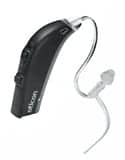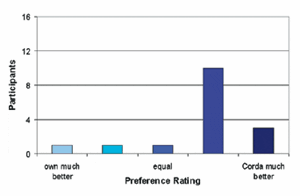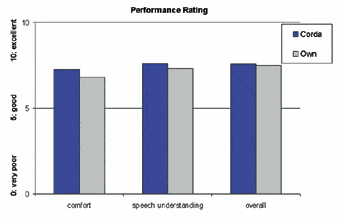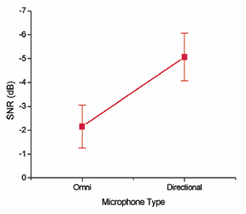Within only a few years, the occlusion effect has been reduced from a major reason for “in the drawer hearing aids,” to today, a time in which we now have effective and easy solutions to the problem.1-3 In fact it was only a few years ago that there were only two methods to solve the problem of occlusion. The first was to build a very long earmold that was contiguous with the cartilaginous portion of the external auditory meatus,4 a solution that is often impractical and can lead to physical discomfort. The second was to counsel the patient about the issue and hope the patient learned to accept it.5 Generally speaking, other possible solutions—such as fine-tuning tools—provided only marginal improvements.
In 2001, Oticon introduced a clinically simple solution to occlusion in the form of the increased ventilation allowed by OpenEar Acoustics.1,3,6 This system was based on the concept that the best method to remove occlusion was to allow low frequency sounds to escape via the ear canal through increasing the vent size.5,7,8 The development of Dynamic Feedback Cancellation, faster hearing aid processing times, and improved vent design (eg, collection vents), combined with a unique vent compensation strategy,9 resulted in larger vents and occlusion-free fittings becoming commonplace.
The key benefits of these fittings were a dramatic reduction in the problems of occlusion and own-voice, and a reported increase in terms of comfort, sound quality, and initial acceptance.1-3 Importantly, when the hearing instrument is designed with these factors in mind, there is no reduction in speech understanding.10
 FIGURE 1. Oticon Corda thin-tube open-fitting (attached to a Syncro BTE). The Corda system is interchangeable with a standard earhook and is designed for Syncro, Tego Pro, and Tego.
FIGURE 1. Oticon Corda thin-tube open-fitting (attached to a Syncro BTE). The Corda system is interchangeable with a standard earhook and is designed for Syncro, Tego Pro, and Tego.
Further refinements and innovations have taken place in the development of occlusion-free fittings. One of the major recent trends has been the development of thinner acoustic tubes (0.8 mm vs. 2.0 mm) combined with a dome-style earmold. As shown in Figure 1, the Oticon Corda consists of a thinner tube and dome earmold that significantly improves the cosmetic appearance of the hearing instrument through reduced tube diameter combined with the reduction of reflective surfaces.
Extending Open Fittings
To further increase the benefit of open fittings, Oticon has extended the ability to combine a thinner tube (0.8 mm vs. 2.0 mm diameter) with an open dome to Oticon Syncro, Tego Pro, and Tego. The clinician can simply detach the standard tube and replace it with a Corda tube (eg, all Oticon fittings are interchangeable between these tubing options). Previous studies have found that this combination of thin tubes with a dome provides the possibility of a totally open and occlusion-free fitting in addition to being more cosmetically satisfying than a standard tubing and open earmold.11
For which patients? Corda has been designed in response to the real-world patient needs addressed by conventional CICs vs BTEs. While both styles offer excellent sound quality and speech understanding in noise, there are patients for whom neither offers the “perfect choice.” These patients require a solution with good cosmetics in addition to totally occlusion-free fittings.
While the CIC offers an excellent cosmetic solution, the restriction placed by the diameter of the human ear canal often means that it is impossible to create a sufficiently large collection vent to provide significant relief from occlusion. CICs can also preclude the use of a volume control, telecoil, or directional microphones. Conversely, traditional BTE solutions offer excellent occlusion reduction through open or skeleton earmolds, but a number of patients find the BTE fitting to be cosmetically unappealing. It is these compromises that Corda aims to solve by combining the best elements of a CIC and BTE fitting.

Audiometrically, this solution is designed for people with good low-frequency hearing with poorer thresholds in the high frequencies (Figure 2). While the open vent allows the escape of low frequency sounds (thus removing the occurrence of occlusion), this same leakage does restrict the amplification that can be provided in the low frequencies. Fortunately, the transmission of sound through a vent is a two-way process so that the patient benefits from the mixing of the direct sound with the amplified sound. The continued development of Dynamic Feedback Cancellation (DFC) systems allows a high frequency hearing loss of up to 70-75 dBHL to be fitted before feedback becomes too great for the DFC system to cope with.
Additionally, when considering this system, it is important to take into consideration factors beyond the audiogram. Factors favoring the system include active younger people looking for a cosmetically appropriate solution, dissatisfied CIC wearers, people who have been previously fitted but may wish for an upgrade, and those people who are primarily looking for help in understanding speech in noise rather than for a full loudness compensation strategy.
Benefits for the Professional
The new system offers a number of benefits to the dispensing professional. By allowing fittings earlier in the fitting process, the patient can try out the hearing instrument before ordering. This also provides the opportunity for the patient and clinician to examine the performance of the hearing instrument using tools like Syncro Live and Syncro Activity Analyzer (eg, datalogging and Envirograms).12,13 Therefore, real-world benefit and specific outcomes for the patient can be addressed earlier.
Alternatively, if you are unsure whether a patient will benefit from this system due to being on the edge of the fitting range, both a thin-tube fitting or a standard open-earmold fitting can be tried simultaneously, as the tubing can be simply removed and switched between the two options. Similarly, this switching of tubes allows existing patients the opportunity to try the new fitting, or for the patient to rest assured that, if their hearing deteriorates, the new system can be simply converted to a standard fitting (eg, allowing access to the maximum fitting range).
Compensating for Open Fittings
Although the software remains essentially unchanged relative to the fitting process, it is important to recognize that “behind the scenes” some important changes have taken place: The underlying gain and compression model has been adjusted to match the physical properties of the Corda, as well as the needs of clients with a mild-to-moderate high-frequency hearing loss. While open fittings are based on the underlying gain and compression model, it is critical that these rationales are extended to incorporate the audiological and acoustic challenges inherent in new fittings. These alterations are based on the years of research on SKI hearing losses combined with our own experiences from open fittings.1-3
One key to ensuring appropriate amplification for people with good low-frequency hearing is that the natural (direct) sound be allowed to mix seamlessly with the amplified sound so as to preserve sound quality. Therefore it is crucial to ensure that the hearing instrument not only has a fast processing time, but that this fast processing is maintained in the low frequencies where the amplified and direct sounds mix.
The total group delay across all frequencies for all Oticon instruments is less than 5 ms—comfortably below the 10 ms limit proposed in the literature.14,15 The good low-frequency hearing and totally open vent means that it is no longer necessary to compensate for the gain lost in the low frequencies (below 1500 Hz). The assumption is that the patient will retain low frequency hearing through the open fitting and residual hearing, so any attempt to provide a low frequency boost will significantly decrease the sound quality. Similarly, the roll-off compensation between the omni and directional modes is decreased so that there is no audible perception of when the hearing aid switches between modes.
In terms of middle and higher frequencies, the use of a thin tube changes the resonance in the acoustic tube connecting the hearing aid and earmold, which therefore needs to be compensated for. In order to prevent feedback from becoming an issue, the original gain prescription and feedback limits are adjusted to ensure that an acceptable fitting range and high frequency sound quality are obtained.
Therefore, adjusting the background audiology to match the acoustic characteristics and needs of the client is crucial. For the clinician, these are automatically taken into consideration in the Genie 7.0 fitting software so that, on a day-to-day level, the transition is seamless.

Field Study
Overall user preference. In order to evaluate the performance of Corda versus standard tubing and open earmolds, 16 adults with good low-frequency hearing and a mild-to-moderate high-frequency hearing loss participated in the study. All participants were experienced wearers of Syncro hearing instruments. The comparison involved participants evaluating the similarities and differences between identical Syncro fittings with either a standard open-mold or a thin-tube (Corda) fitting.
In terms of preference, Figure 3 demonstrates that the majority of participants preferred the thin-tube fittings to the standard open earmolds. The top-three reasons for preferring these fittings were 1) sound quality (comfortable sound); 2) physical comfort; and 3) perceived benefits in terms of speech understanding.

Performance ratings. Recent reports have indicated the significant benefits that Syncro provides.10,16-18 Given this, it was crucial in our development of the thin-tube system that the same performance was obtained. Figure 4 indicates the results of the pre- and post-test questionnaire results across the variables of comfort, speech understanding, and overall performance. Analysis indicates that there are no significant difference in terms of sound processing performance between fittings with Corda and those obtained using standard tubing and open earmolds. Furthermore, analysis of speech perception testing in quiet and noise found no significant difference between performance with Syncro with or without Corda fittings. This strongly suggests that the performance benefits obtained with Syncro were not compromised by using the thin-tube approach.
Can Directionality be Preserved Using Open Fittings?
A number of reports have questioned the ability to preserve directionality using an open fitting. This has become especially the case since the recent development of thin tubes with totally open solutions (ie, similar to Corda). The main argument is that the totally open vent allows too much loss of low frequency directivity, in addition to the leakage of non-processed noise, through the now fully open ear canal. A recent study by Flynn10 using Syncro suggested that it was possible to preserve directionality with open fittings. Additionally, when the directional system was designed with open fittings in mind, there was actually no relationship between vent size and directional benefit.

The present study replicated the design of the first study and sought to evaluate the performance of directional microphones in a 6-speaker diffuse field, with speech coming from the front speaker. Results indicated a significant (p<.01) directional benefit of 2.92 dB between the omnidirectional and full directional settings of Corda (Figure 5). It should be noted that this value is not statistically different than the directional benefit in Syncro reported in previous studies10,16,17 (eg, between 3.07-3.20 dB) or of the directional benefit reported previously in the literature using competitive products.19,20
It should be noted, however, that there was variability in performance between the two fittings. Therefore, if the main concern of the patient is speech understanding in noise, it may be prudent for the dispensing professional to test the aid with both a standard open fitting and the thin-tube option to ensure that maximum benefit is obtained.
Similar to previous studies, it can be concluded that it is possible to preserve directionality with a totally open fitting. The key argument as to why directionality can be maintained is the high-frequency emphasis of the directional microphones used in these hearing instruments. Similarly, the good, residual, low-frequency hearing results in less issues regarding the upward spread of masking, as well as good residual auditory capabilities making it possible to separate the speech from the noise in the low frequencies using the natural resonance of the ear canal.
Summary
The present study indicates that this thin-tube open-fitting option provides occlusion-free hearing while maintaining the previously reported speech understanding and comfort benefits of a conventional tubing with an open earmold. Importantly, speech understanding in noise is not compromised
For the clinician, this new fitting option offers the opportunity to better meet the needs of those clients for whom a CIC may not be appropriate. The system also has the advantage of being able to be instantly configured to a standard earmold if more amplification is required at some stage in the future (eg, progressive hearing loss) without the patient needing to replace the whole hearing aid. Similarly, by utilizing a standard BTE, rather than a dedicated solution, the wearer benefits from access to a volume control, program choices, and telecoil.
| This article was submitted to HR by Mark C. Flynn, PhD, Lise Obeling, MS, and Jørn Johansen, MS. Flynn is director of product concept definition, and Obeling and Johansen are audiologists at Oticon A/S, Smørum, Denmark. Correspondence can be addressed to HR or Mark C. Flynn, PhD, Oticon A/S, Kongebakken 9, Smørum, DK2765, Denmark; email: [email protected]. |
References
1. Flynn MC. Opening ear fittings: Nine questions and answers. The Hearing Review. 2004;11(3):58-88.
2. Kochkin S. MarkeTrak V: "Why my hearing aids are in the drawer": The consumer’s perspective. Hear Jour. 2000;53(2):32-42.
3. Flynn MC. Opening ears: The scientific basis for an open ear acoustic system. The Hearing Review. 2003;10(5):34-67.
4. Pirzanski C. Diminishing the occlusion effect: Clinician/manufacturer factors. Hear Jour. 1998;51(4):66-78.
5. Pogash RR, Williams CN. Occlusion and own voice issues: Protocols and strategies. The Hearing Review. 2001;8(3):48-54.
6. Hansen LB. Adapto study. In: News from Oticon: Audiological Research Documentation. Copenhagen, Denmark: Oticon Inc; April 2002.
7. Dillon H. Hearing Aids. New York: Thieme; 2001.
8. Carle R, Laugesen S, Nielsen C. Observations on the relations among occlusion effect, compliance, and vent size. J Am Acad Audiol. 2002;13:25-37.
9. Bramslow L, Jørgensen M, Lundh P, Obeling L. Compensating for the hearing aid vent: Is it trivial? Presented at: Intl Hearing Aid Research Conference, Lake Tahoe: August 25-29, 2004.
10. Flynn MC. Maintaining the directional advantage in open fittings. The Hearing Review. 2004;11(11):32-6.
11. Kiessling J, Brenner B, Jespersen CT, Groth J, Jensen OD. Occlusion effect of earmolds with different venting systems. J Am Acad Audiol. 2005;16(4):237-49.
12. Flynn MC. Datalogging: A new paradigm in the hearing instrument fitting process. The Hearing Review. 2005;12(3):52-7.
13. Flynn MC. Envirograms: Bringing greater utility to datalogging. The Hearing Review. 2005;12(11):32-28.
14. Stone MA, Moore BCJ. Tolerable hearing aid delays I. Estimation of limited imposed by the auditory path alone using simulated hearing losses. Ear Hear. 1999;20:182-92.
15. Stone MA, Moore BCJ. Tolerable hearing aid delays. II. Estimation of limits imposed during speech production. Ear Hear. 2002;23(4):325-38.
16. Flynn MC, Lunner T. Clinical evidence for the benefits of Oticon Syncro. In: News from Oticon. Copenhagen, Denmark: Oticon Inc. November 2004: 1-10.
17. Flynn MC, Lunner T. Clinical verification of a hearing aid with artificial intelligence. Hear Jour. 2005;58(2):34-8.
18. Flynn MC, Pogash RR, Schum DJ. Multinational clinical evaluation of Oticon Syncro. In: News from Oticon; Copenhagen, Denmark: Oticon Inc. February 2005:1-10.
19. Jespersen CT, Olsen SØ. Does directional benefit vary systematically with omnidirectional performance? The Hearing Review. 2003;10(11):16-24,62-63.
20. Valente M, Mispagel KM. Performance of an automatic adaptive dual-microphone ITC digital hearing aid. The Hearing Review. 2004;11(2):42-46,71.





